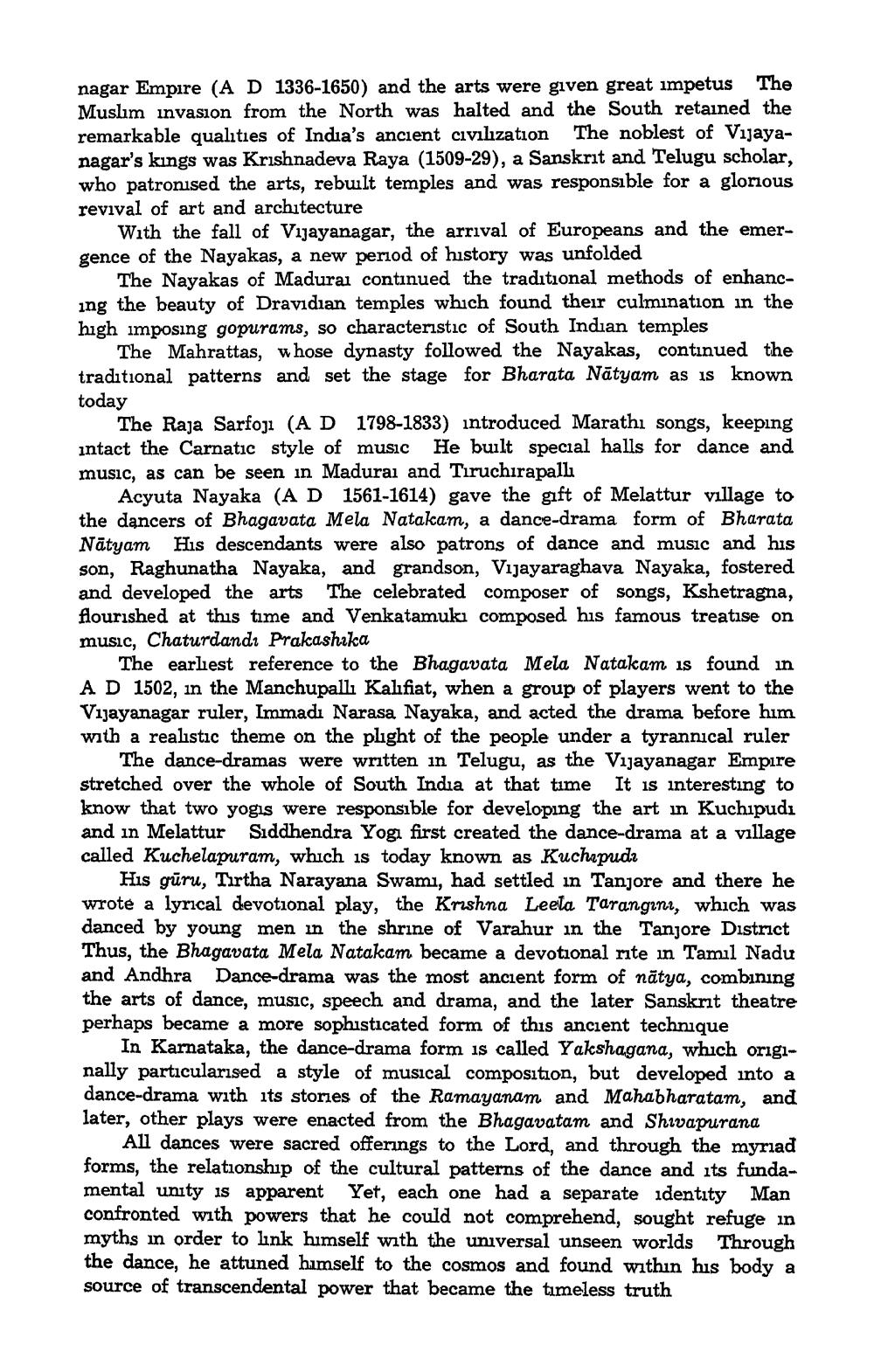Book Title: Sacred Dance of India Author(s): Mrinalini Sarabhai Publisher: Bharatiya Vidya Bhavan View full book textPage 8
________________ nagar Empire (A D 1336-1650) and the arts were given great impetus The Muslim invasion from the North was halted and the South retained the remarkable qualities of India's ancient civilization The noblest of Vijayanagar's kings was Krishnadeva Raya (1509-29), a Sanskrit and Telugu scholar, who patronised the arts, rebuilt temples and was responsible for a glorious revival of art and architecture With the fall of Vijayanagar, the arrival of Europeans and the emergence of the Nayakas, a new period of history was unfolded The Nayakas of Madurai continued the traditional methods of enhancing the beauty of Dravidian temples which found their culmination in the high imposing gopurams, so characteristic of South Indian temples The Mahrattas, whose dynasty followed the Nayakas, continued the traditional patterns and set the stage for Bharata Nātyam as is known today The Raja Sarfoji (AD 1798-1833) introduced Marathi songs, keeping intact the Carnatic style of music He built special halls for dance and music, as can be seen in Madurai and Tiruchirapalli Acyuta Nayaka (A D 1561-1614) gave the gift of Melattur village to the dancers of Bhagavata Mela Natakam, a dance-drama form of Bharata Nātyam His descendants were also patrons of dance and music and his son, Raghunatha Nayaka, and grandson, Vijayaraghava Nayaka, fostered and developed the arts The celebrated composer of songs, Kshetragna, flourished at this time and Venkatamuki composed his famous treatise on music, Chaturdandı Prakashika The earliest reference to the Bhagavata Mela Natakam is found in A D 1502, in the Manchupalli Kalifiat, when a group of players went to the Vijayanagar ruler, Immadı Narasa Nayaka, and acted the drama before him with a realistic theme on the plight of the people under a tyrannical ruler The dance-dramas were written in Telugu, as the Vijayanagar Empire stretched over the whole of South India at that time It is interesting to know that two yogis were responsible for developing the art in Kuchipudi and in Melattur Siddhendra Yogi first created the dance-drama at a village called Kuchelapuram, which is today known as Kuchipudz His gūru, Tirtha Narayana Swami, had settled in Tanjore and there he wrote a lyrıcal devotional play, the Krishna Leela Tarangini, which was danced by young men in the shrine of Varahur in the Tanjore District Thus, the Bhagavata Mela Natakam became a devotional rite in Tamil Nadu and Andhra Dance-drama was the most ancient form of nātya, combining the arts of dance, music, speech and drama, and the later Sanskrit theatre perhaps became a more sophisticated form of this ancient technique In Karnataka, the dance-drama form is called Yakshagana, which originally particularised a style of musical composition, but developed into a dance-drama with its stories of the Ramayanam and Mahabharatam, and later, other plays were enacted from the Bhagavatam and Shivapurana All dances were sacred offerings to the Lord, and through the myriad forms, the relationship of the cultural patterns of the dance and its fundamental unity is apparent Yet, each one had a separate identity Man confronted with powers that he could not comprehend, sought refuge in myths in order to link himself with the universal unseen worlds Through dance, he attuned himself to the cosmos and found within his body a source of transcendental power that became the timeless truthPage Navigation
1 ... 6 7 8 9 10 11 12 13 14 15 16 17 18 19 20 21 22 23 24 25 26 27 28 29 30 31 32 33 34 35 36 37 38 39 40 41 42 43 44 45 46 47 48
